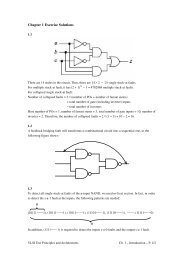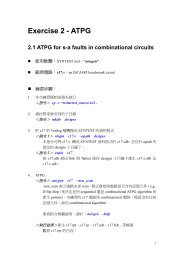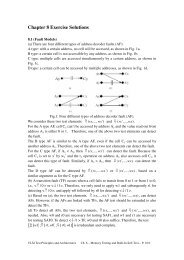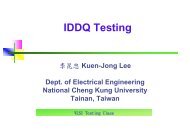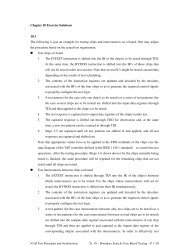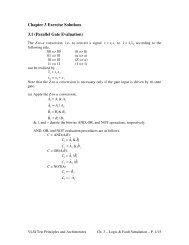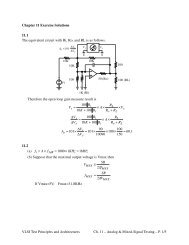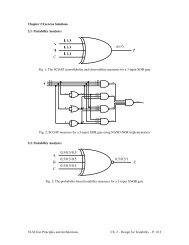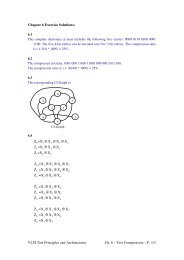36~chapter 04 atpg.pdf
36~chapter 04 atpg.pdf
36~chapter 04 atpg.pdf
You also want an ePaper? Increase the reach of your titles
YUMPU automatically turns print PDFs into web optimized ePapers that Google loves.
f/1, a/0,a/1, c/1}<br />
(d) The set of faults that are untestable when b=1 is<br />
{b/1, c/1, d/1}<br />
(e) The set of untestable faults based on the stem analysis of b is the<br />
intersection of the (c) and (d), which is {c/1, d/1}<br />
4.18 (PODEM)<br />
(a) c/0: The first objective is c=1, which backtraces to b=1. Next, to<br />
propagate the fault, the objective is a=1. At this time the D-frontier<br />
is {g}. The next objective is f=0. With simulation, the fault is detected.<br />
So the vector is abf=110.<br />
(b) c/1: The first objective is c=0, which backtraces to b=0. Next, to<br />
propagate the fault, a=1. At this time the D-frontier is g. The next<br />
objective is f=0. With fault simulation we obtain that the fault is blocked.<br />
So we backtrack to f=1. This also blocks the fault. So we revert f=X and<br />
backtrack to a=0. This also blocks the fault. Finally we backtrack to b=1.<br />
This cannot excite the fault. We are now at the root of the decision tree.<br />
No more backtracks are possible. Thus the fault is untestable.<br />
(c) d/0: The first objective is d=1, which backtraces to b=1. With<br />
simulation we obtain the D-frontier to be {z}. The next objective is g=1.<br />
Backtracing through an X-path leads us to f=0. Simulating at this time,<br />
the D-frontier is still the same. The previous objective g=1 is not yet<br />
justified. So we backtrace from g=1 again via an X-path. This time it takes<br />
us to a=1. With simulation the fault is detected. So the vector is abf=110.<br />
(d) d/1: The first objective is d=0, which backtraces to b=0. At this time<br />
the D-frontier is empty since g=0. So we backtrack to b=1. But this cannot<br />
excite the fault. Thus we backtrack again. No backtracks are possible,<br />
thus the fault is untestable.<br />
4.21 (Untestable Fault Identification)<br />
If a fault f is combinationally untestable, then there exists no input<br />
(PPI, PI) that can excite it and propagate it to any of PPO or PO. This<br />
means that it is impossible in the sequential circuit that can take the<br />
circuit to a state ∈ PPI with any PI that can excite f and propagate its<br />
fault effects to either primary outputs or to the next-state flip-flops.<br />
Thus, f is also sequentially untestable.<br />
4.22 (FAN)<br />
VLSI Test Principles and Architectures Ch. 4 – Test Generation – P. 6/8



